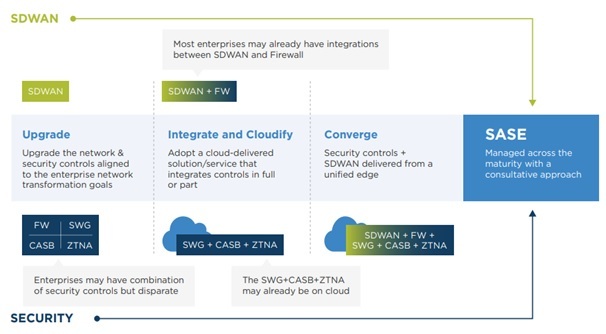In the final part of this series, Song Toh, VP Global Network Services at Tata Communications, looks at more recent innovations in networking technology that have...
Enterprises today are re-evaluating traditional networks and increasingly adopting new technologies such as software-defined wide area network (SD-WAN) for reliably connecting distributed resources. Massive network expansion and device proliferation is making cloud enablement, robust cybersecurity, and seamless orchestration and interoperability critical for organisations, especially in fragmented operational landscapes. In this article, Rajarshi Purkayastha, Head of Pre-Sales in the Americas for Tata Communications, explores the role of secure access service edge (SASE) technology for enterprises.
SASE combines security and a modern network as service capabilities to ensure seamless connectivity and data protection without compromising on user experience. And its growing emphasis can be gauged by increasing industrial acceptance. As per Gartner’s SASE Forecast Analysis 1, the global market for SASE is expected to be worth $15 billion by 2025, growing at a remarkable CAGR of 36% since 2021. This blog covers the basics of SASE and how it can empower enterprises towards the future. The larger aspect of SASE and its significance SASE represents a holistic framework that unifies wide-area networking (WAN) and network security within a single cloud-based service approach. It ensures secure access to applications and resources for users, irrespective of their location, device, or network, by delivering integrated security and networking service capabilities including SD-WAN, SWG, CASB, NGFW and Zero Trust Network Access (ZTNA). As remote operations and cloud service usage grow, SASE provides a convenient, fast, cost-effective, and scalable solution for networking and security. Reports indicate that
60% of enterprises will have definitive strategies and timelines in place for SASE adoption by 2025, up from 10% in 2020, highlighting enterprise urgency in adopting SASE for their short- and long-term operational goals. Here are some of the defining traits of SASE that create a differentiator:
As remote operations and cloud service usage grow, SASE provides a convenient, fast, cost-effective, and scalable solution for networking and security. Reports indicate that
60% of enterprises will have definitive strategies and timelines in place for SASE adoption by 2025, up from 10% in 2020, highlighting enterprise urgency in adopting SASE for their short- and long-term operational goals. Here are some of the defining traits of SASE that create a differentiator:
- A holistic framework: The SASE framework is built on multiple technologies and combines various components to develop a unified platform that can drive operations seamlessly across environments, endpoints, and locations. While SASE depends on software-define networks, it is more than just revolutionised SD-WAN or a point product. Instead, SASE is an end-to-end approach to connecting data, applications, and users, and in the process, offering improved flexibility, scalability, and security to enterprises.
- Strategic integrations: Due to the incorporation of various technologies from different vendors, the framework’s true strength lies in the proficiency of its integration. The engineering complexities involved in harmonising technologies from different sources into a unified solution are substantial. However, SASE facilitates this integration offering a well-rounded computing solution aligned with the changing business and digital paradigm.
- Immersive experiences: SASE integrates security and network functionality to enhance application, end-user, and administrative experiences within its technological framework. The ultimate objective is ensuring every user or endpoint enjoys access to the required resources securely and efficiently.
- A clear understanding of the objectives
- Setting network performance targets
- Preparing for multi-cloud connectivity
- Emphasising secured branch networking and security tooling
- Modernising applications
- Servicing and measuring progress regularly.
- Convergence of technologies: The SASE framework emphasises combining various technological innovations and augmenting human capabilities. A common framework to analyse users, applications, and data enables faster issue resolution and informed decision-making.
- Improved IT efficiency: With fast deployment, centralised orchestration, and analytics-driven role-based management, SASE promises to offer the enterprise IT teams greater observability and control. This results in improved decision-making and enhanced IT effectiveness.
- Improved and secured remote access: SASE delivers user-centric security, avoids traffic backhauling to policy enforcement points, and optimises user experience by anchoring clients to the right SASE gateway. This reduces latency and helps detect malicious traffic to intervene and prevent threats.
 Despite its benefits, enterprises are often daunted by the large-scale architectural changes and implementation challenges of SASE adoption. As a result, a plug-and-play approach with point solutions are often preferred. However, the key tenet of SASE is holistic transformation that facilitates secure and value-based outcomes, which is ideally a major value proposition that a managed service provider (MSP) can bring to the table. Drawing from experiences across various industries, MSPs exhibit adaptability and flexibility, resulting in cost-effective and swift deployments as well as issue resolution with their consultative approach. MSPs elevate network performances by underlaying infrastructure and providing unified management of underlay and overlay within a single managed service. With a single point of accountability, MSPs take responsibility for service chaining, integrating multiple virtual network functions, and implementing future technology upgrades. They also offer continued support and training, progress management services, and future planning, making SASE implementation a truly end-to-end process. By opting for a managed SASE solution, organisations can significantly reduce initial investments and operational overhead, freeing up in-house IT for more valuable tasks.
Doing it right with Tata Communications At Tata Communications, we have designed our SASE offerings to be evolutionary, not just revolutionary. Our three-phased SASE approach involves meticulously thought out and tailormade security and network upgradations that are aligned with enterprise network transformation goals, thorough integration and unification on the cloud, and convergence of network functions and security solutions. Our Managed SASE offerings improve business agility, observability, and control, simplify network and security management, and reduce costs.
Despite its benefits, enterprises are often daunted by the large-scale architectural changes and implementation challenges of SASE adoption. As a result, a plug-and-play approach with point solutions are often preferred. However, the key tenet of SASE is holistic transformation that facilitates secure and value-based outcomes, which is ideally a major value proposition that a managed service provider (MSP) can bring to the table. Drawing from experiences across various industries, MSPs exhibit adaptability and flexibility, resulting in cost-effective and swift deployments as well as issue resolution with their consultative approach. MSPs elevate network performances by underlaying infrastructure and providing unified management of underlay and overlay within a single managed service. With a single point of accountability, MSPs take responsibility for service chaining, integrating multiple virtual network functions, and implementing future technology upgrades. They also offer continued support and training, progress management services, and future planning, making SASE implementation a truly end-to-end process. By opting for a managed SASE solution, organisations can significantly reduce initial investments and operational overhead, freeing up in-house IT for more valuable tasks.
Doing it right with Tata Communications At Tata Communications, we have designed our SASE offerings to be evolutionary, not just revolutionary. Our three-phased SASE approach involves meticulously thought out and tailormade security and network upgradations that are aligned with enterprise network transformation goals, thorough integration and unification on the cloud, and convergence of network functions and security solutions. Our Managed SASE offerings improve business agility, observability, and control, simplify network and security management, and reduce costs.
 Learn more about how a managed service approach can help you build your SASE implementation right in our next blog post. Sources:
Learn more about how a managed service approach can help you build your SASE implementation right in our next blog post. Sources:
Leaders In Our Own Right
Explore related solution
In my next few blogs, I’ll be talking about Software Defined Networks - SDNs. This subject is currently a very hot topic around the networking world. I’ll spend the next...
By upgrading networks to 100G, service providers are investing in the future of their networks and securing future capacity demand. The challenge is deciding when to do...
What’s next?
Explore Our Solutions
Explore our solutions through immersive platform demos or engage with our surveys and pricing calculators
Explore Our Solutions
Explore our solutions through immersive platform demos or engage with our surveys and pricing calculators
Explore Our Solutions
Explore our solutions through immersive platform demos or engage with our surveys and pricing calculators


.png?width=310&height=159&name=image%20(1).png)